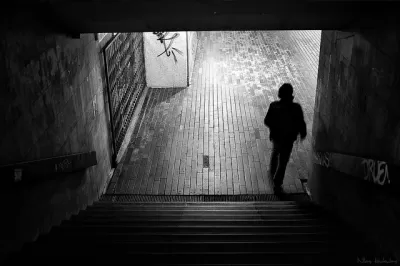The October issue of Land Lines reveals the remarkable story of how an estimated one million people came to live in subterranean apartments in Beijing.

Annette M. Kim, associate professor at the Sol Price School of Public Policy at the University of Southern California, reports on the market and policy conditions that drove so many residents to live underground.
According to the abstract for the article, "an estimated one million people are living in subterranean apartments in Beijing, where affordable housing near employment is scarce for the greater city’s 23 million inhabitants (Xing 2011). These units are often windowless subdivisions in basements and air raid shelters, and the median size is 9.75 square meters."
The city's subterranean spaces result "from a policy dating to 1950 that requires all new buildings to have common basements and air defense shelters. Construction codes specify building guidelines, including the provision of infrastructure such as electricity, water, and sewers. This supply of underground space has grown exponentially amid China’s extraordinary building boom in recent decades. Some complexes contain as many as 600 units below street level."
The article provides analysis of the underground market, the housing policy that enabled, and then reacted to, the underground conditions, and recommendations for making rental housing affordable in Beijing.
FULL STORY: Hidden City: Beijing’s Subterranean Housing Market

Depopulation Patterns Get Weird
A recent ranking of “declining” cities heavily features some of the most expensive cities in the country — including New York City and a half-dozen in the San Francisco Bay Area.

California Exodus: Population Drops Below 39 Million
Never mind the 40 million that demographers predicted the Golden State would reach by 2018. The state's population dipped below 39 million to 38.965 million last July, according to Census data released in March, the lowest since 2015.

Chicago to Turn High-Rise Offices into Housing
Four commercial buildings in the Chicago Loop have been approved for redevelopment into housing in a bid to revitalize the city’s downtown post-pandemic.

New Park Opens in the Santa Clarita Valley
The City of Santa Clarita just celebrated the grand opening of its 38th park, the 10.5-acre Skyline Ranch Park.

U.S. Supreme Court: California's Impact Fees May Violate Takings Clause
A California property owner took El Dorado County to state court after paying a traffic impact fee he felt was exorbitant. He lost in trial court, appellate court, and the California Supreme Court denied review. Then the U.S. Supreme Court acted.

How Urban Form Impacts Housing Affordability
The way we design cities affects housing costs differently than you might think.
City of Costa Mesa
Licking County
Barrett Planning Group LLC
HUD's Office of Policy Development and Research
Mpact Transit + Community
HUD's Office of Policy Development and Research
City of Universal City TX
ULI Northwest Arkansas
Town of Zionsville
Urban Design for Planners 1: Software Tools
This six-course series explores essential urban design concepts using open source software and equips planners with the tools they need to participate fully in the urban design process.
Planning for Universal Design
Learn the tools for implementing Universal Design in planning regulations.





















